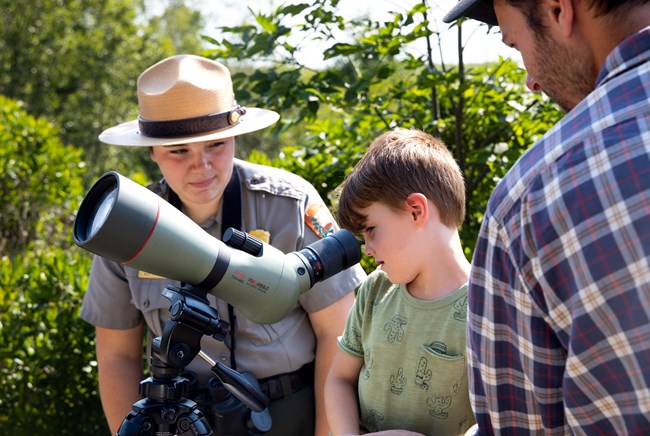Last updated: September 28, 2021
Article
Celebrating 30 Years of Peregrine Falcons at Precipice

Ashley Conti, Friends of Acadia, NPS

Emma Forthover, Friends of Acadia, NPS
Peregrine falcons are very special residents of Acadia National Park. Not only are they fascinating birds with extreme adaptations, but fascinating and extreme efforts were made to save their presence in this park. Like many other bird species in the 1950’s, peregrine falcon populations nationwide were decimated by the use of DDT, a chemical pesticide. The effects of DDT spread through ecosystems, inspiring people to successfully call for its prohibition.
After learning that peregrine falcons were extirpated (locally extinct) in the eastern United States, Cornell University began a massive effort to reintroduce the species in 1972. The reintroduction used a process called “hacking,” which involved captive breeding of peregrine falcons from all over the world. Wildlife biologists monitored the eggs as they hatched in incubators. The young chicks were placed on cliffsides while inside “hack boxes.” Once the young grew to fledgling age, the biologists opened the boxes and the birds took to the sky – carrying hopes of them imprinting on the mountain and thus returning to the park to lay their own eggs.
Acadia National Park was selected as a priority hacking site in Maine due to its number of cliffs and historic nesting sites. Between 1984 and 1986, 22 chicks were released at Jordan Cliffs. Fast forward to the year 1991. Acadia National Park biologist Bruce Connery waits patiently to see if any of the released chicks will return. A young male named Ganesh, who was released in 1986, has already returned for a few seasons but has yet to produce any offspring. But during the spring of 1991 he returns and his mate lays eggs – the first successful nest in Acadia since 1956!

Lily LaRegina, Friends of Acadia, NPS
Peregrine Falcons in 2021
So here we are, in the year 2021, celebrating our 30th anniversary of nesting peregrine falcons in Acadia! This year, three breeding pairs made their homes on Acadia’s grand cliffs: one near Valley Cove Trail (west of Somes Sound), one near Jordan Cliffs Trail (west of Jordan Pond), and one near Precipice Trail (on the east facing side of Champlain Mountain). Two chicks from each pair survived to fledge and are, as of late August, still flying the skies near where they were born.
The Peregrine Falcon Watch program, staffed by Acadia National Park since 1994, remains one of Acadia’s most popular visitor experiences. This year, the program was held every weekday from 9am-12pm (weather permitting) at Precipice Trailhead and was offered from late May through the end of July. During that time we spoke with over 4,500 visitors: families, junior rangers, experienced birders, tour groups, hikers, first-timers, climbers, and many more! The program is for all ages and birding experience. Staff members not only connect visitors to this remarkable sight, but also help monitor the falcons, keeping track of their behavior and development.

Lily LaRegina, Friends of Acadia, NPS
Peregrine Falcon Watch Program Grows
With so many visitors, it was essential to have two rangers at each program. One ranger focused on interpretation and helping people use the scopes, while the other redirected traffic from the Precipice Trail and answered visitors’ questions. The increase in rangers dedicated to the program (up to 7 total rangers this summer from 2 rangers in previous seasons) helped accommodate larger crowds during this unusually busy summer.
Also new this year was the addition of specialized equipment and educators from Friends of Acadia (FOA). FOA staff installed a spotting scope that transmitted images to a large television screen. This created an opportunity for large groups to simultaneously see live images of the birds, and also made viewing easier for people who had difficulty using the spotting scopes (most notably young children and visitors with visual impairments). FOA staff members also helped answer questions and chatted with visitors, which made the program even more enjoyable.

Ashley L. Conti, Friends of Acadia, NPS
The Peregrine Falcon Watch team had an excellent 2021 season connecting visitors from around the world to these fascinating animals. Peregrine falcons in Acadia have come a long way since their reintroduction here in the 1980s. The wildlife biologists who carefully raised chicks in cliffside boxes and waited patiently for Ganesh&#’;s return and successfully nest in 1991 or the visitors who watch the falcons swoop and dive today, the emotion is certainly the same: wonder at these amazing animals and their lives in Acadia.
